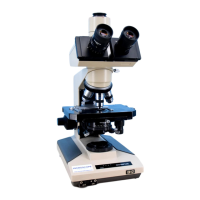e) When the right and left optical axes are
Left optical axis
Center cross hair
Fig.
11-19
compared with each other in Fig. 11-19,
for example, the right optical axis
is
nearer
the center cross hair on
KN0005. In this
case, the left optical
;xis must therefore
be adjusted within 2 divisions of the right
-
Center cross hair
.-
-
/
optical axis on thescale of KN0005 (within
the black enclosure).
(See Fig. 11 -19)
The left optical axis should (1)
edeally be
matched with the right optical axis or (2)
Right optical axis
""-
be within 2 divisions
at
the upper left
corner inside the black enclosure. Position
of the left optical axis within 2 divisions
at
the lower right corner of the black
enclosure
is
the least desirable, although
the specification is met. Adjust the left
optical axis
as
close to the center cross
hair on
KN0005 in condition (1) or (2)
described above, if possible.
f) If the right and left optical axes cannot be
adjusted within
2
divisions of the center
cross hair on
thc scale of KN0005, repeat
adjustment
iri
slep 1 1
-2
above.
11-6-2
lmage
shift Ily atJjustlnent of interpupillary
distance
Image for
tnstiot)
plar~o
of objective: Within
0.1
a)
Placr?
the
followi~lg Jigs on the Microscope
Stand:
Ccr~ tering ohjc!ctive: K N 0005
1
Ox
~;yepicce with cross Iiair: C-1
b)
Put
C
1 into the right side eyepiece sleeve.
Wit11 the interpupillary distance set
at
the
tnirii~num, check the 10x eyepiece for
Irscijlion of
its
cross hair on the scale of
I<NCl005. Then, increase interpupillary
disaa~lce to maximum and read shift of
the
cross hair image (on the scale of
KNBO05).
SPAN DAR D: Within 1 division
c)
Put
C-1 into the left eyepiece sleeve and
cticcl< image of the cross hair in the
indentical manner.
d)
If the STANDARD
is
not met, repeat
adjustment in step 11-3 above. (Especially
take care not to leave gap between the
Prism and Prism Mount.)

